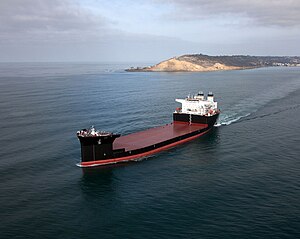 USNS John Glenn (T-ESD-2) sea trials in 2014 | |
| Class overview | |
|---|---|
| Builders | General Dynamics |
| Operators | United States Navy |
| Planned | 5 |
| Building | 4 |
| General characteristics | |
| Tonnage | >60,000 metric dwt[1] |
| Length | 785 ft (239 m)[1] |
| Beam | 164 ft (50 m)[1] |
| Draft | 39.37 ft (12.00 m)[1] |
| Propulsion |
|
| Speed | >15 knots (28 km/h; 17 mph)[1] |
| Range | 9,500 nautical miles (17,600 km; 10,900 mi) at 15 knots[1] |
| Boats & landing craft carried | 3 LCAC |
| Aviation facilities | ESB variant: Hangar for 2 × CH-53 and large flight deck |
An Expeditionary Transfer Dock (ESD), formerly the Mobile Landing Platform (MLP), is designed to be a semi-submersible, flexible, modular platform providing the US Navy with the capability to perform large-scale logistics movements such as the transfer of vehicles and equipment from sea to shore. These ships significantly reduce the dependency on foreign ports and provide support in the absence of port availability. The class also houses a sub-class variant called the Expeditionary Mobile Base (ESB), formerly the Afloat Forward Staging Base (AFSB).
The ESD and ESB are part of a new ship class added in 2015 with an E as a new designator, similar to the L-class amphibious ships, S-class submarines, A-class auxiliaries and more. These three E-class ships were previously listed as seabasing ships in the Naval Vessel Register. In May 2011, General Dynamics NASSCO received a $744 million contract modification to fully fund the construction of the first two ships of the class, USNS Montford Point (ESD-1) and USNS John Glenn (ESD-2). Additional funding of $115 million for long lead time material and advanced design was awarded in August 2011.
The first ship of the ESD program, USNS Montford Point (ESD-1) was delivered in May 2013, and the second ship, USNS John Glenn (ESD-2), was delivered March 12, 2014. In 2012, a third MLP, USS Lewis B. Puller (ESB-3), was added to the contract and reconfigured as an Expeditionary Mobile Base (ESB), or formerly known as an MLP Afloat Forward Staging Base (AFSB). All three ships have been delivered to the U.S. Navy.
In September 2015, the Navy decided to redesignate the MLP as the Expeditionary Transfer Dock (ESD) and the AFSB as the Expeditionary Mobile Base (ESB).[2] The Navy plans to procure six Expeditionary Mobile Bases (ESBs) in total, with a fourth (ESB-6) ordered in FY2018, a fifth (ESB-7) ordered in FY2019, and the sixth and final ship (ESB-8) with an order date yet to be determined.[3]
In mid-2022, the Marine Corps announced its intention to retire both ESD ships[4] after less than a decade of active service, but this was rejected by Congress in December 2022.[5] The ships were subsequently placed in reduced operating status.
- ^ a b c d e f g "USNS John Glenn (MLP 2) Christening Ceremony" (PDF). General Dynamics NASSCO. 1 February 2014. pp. 14–16. Archived from the original (pdf) on 4 March 2016. Retrieved 28 September 2014.
- ^ "A New Class of Ship – 'Expeditionary Support'". Navy Times, 3 September 2015
- ^ "Navy Ship Names: Background for Congress". fas.org. 28 February 2019. Retrieved 2 March 2019.[permanent dead link]
- ^ "Marines still have big plans for seabasing ships as 2 head for mothballs". Defense News. 20 June 2022.